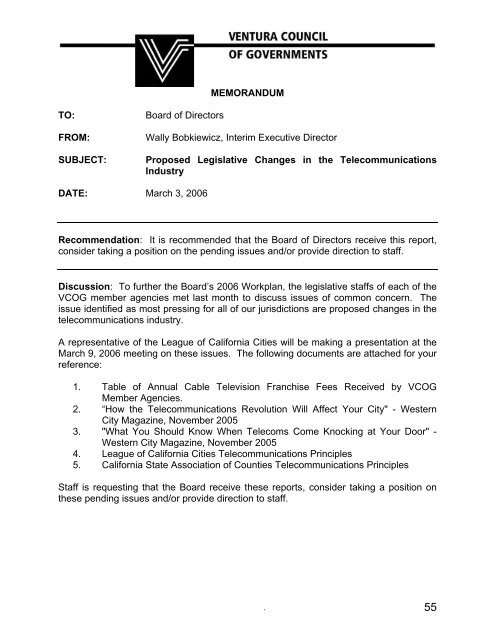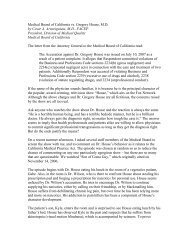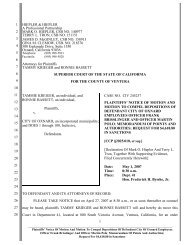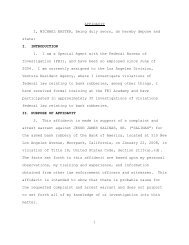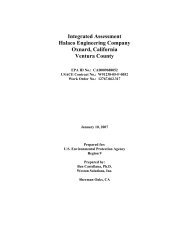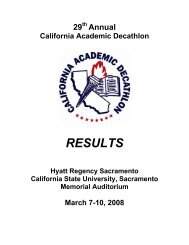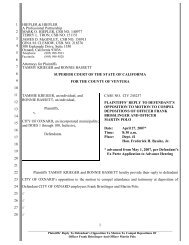MEMORANDUM TO: Board of Directors FROM: Wally Bobkiewicz ...
MEMORANDUM TO: Board of Directors FROM: Wally Bobkiewicz ...
MEMORANDUM TO: Board of Directors FROM: Wally Bobkiewicz ...
You also want an ePaper? Increase the reach of your titles
YUMPU automatically turns print PDFs into web optimized ePapers that Google loves.
<strong>MEMORANDUM</strong><br />
<strong>TO</strong>:<br />
<strong>FROM</strong>:<br />
SUBJECT:<br />
<strong>Board</strong> <strong>of</strong> <strong>Directors</strong><br />
<strong>Wally</strong> <strong>Bobkiewicz</strong>, Interim Executive Director<br />
Proposed Legislative Changes in the Telecommunications<br />
Industry<br />
DATE: March 3, 2006<br />
Recommendation: It is recommended that the <strong>Board</strong> <strong>of</strong> <strong>Directors</strong> receive this report,<br />
consider taking a position on the pending issues and/or provide direction to staff.<br />
Discussion: To further the <strong>Board</strong>’s 2006 Workplan, the legislative staffs <strong>of</strong> each <strong>of</strong> the<br />
VCOG member agencies met last month to discuss issues <strong>of</strong> common concern. The<br />
issue identified as most pressing for all <strong>of</strong> our jurisdictions are proposed changes in the<br />
telecommunications industry.<br />
A representative <strong>of</strong> the League <strong>of</strong> California Cities will be making a presentation at the<br />
March 9, 2006 meeting on these issues. The following documents are attached for your<br />
reference:<br />
1. Table <strong>of</strong> Annual Cable Television Franchise Fees Received by VCOG<br />
Member Agencies.<br />
2. “How the Telecommunications Revolution Will Affect Your City" - Western<br />
City Magazine, November 2005<br />
3. "What You Should Know When Telecoms Come Knocking at Your Door" -<br />
Western City Magazine, November 2005<br />
4. League <strong>of</strong> California Cities Telecommunications Principles<br />
5. California State Association <strong>of</strong> Counties Telecommunications Principles<br />
Staff is requesting that the <strong>Board</strong> receive these reports, consider taking a position on<br />
these pending issues and/or provide direction to staff.<br />
,<br />
55
Annual Cable Television Franchise Fees<br />
Received By VCOG Member Agencies<br />
Franchise<br />
Fee<br />
General Fund<br />
Budget<br />
Camarillo $637,558 $25,051,022<br />
Fillmore $156,000 $5,149,354<br />
Moorpark $245,000 $11,925,302<br />
Ojai $71,300 $6,694,221<br />
Oxnard $750,000 $104,500,135<br />
Port Hueneme $148,000 $15,326,600<br />
Santa Paula $226,000 $9,474,070<br />
Simi Valley $994,805 $62,000,000<br />
Thousand Oaks $1,300,000 $71,642,480<br />
Ventura $727,296 $84,664,236<br />
County <strong>of</strong> Ventura $600,000 $810,512,412<br />
<strong>TO</strong>TAL $5,855,959<br />
NOTES:<br />
1. General Fund budget for each agency is shown for reference.<br />
Each City funds a different variety <strong>of</strong> municipal services from their<br />
General Fund depending on special districts serving their jurisdiction.<br />
03-Mar-06<br />
56
League <strong>of</strong> California Cities<br />
http://www.cacities.org/story_display.jsp?displaytype=pf&zone=wcm§ion=&sub_sec=&tert=&stor...<br />
Page 1 <strong>of</strong> 4<br />
03/03/2006<br />
2006-03-03<br />
How the Telecommunications Revolution Will Affect Your City<br />
November 2005<br />
There's a revolution under way in the area <strong>of</strong> telecommunications - on cable and satellite, over broadband and "wi-fi" (wireless) Internet,<br />
and via telephone lines and cellular phones. It's happening right now in cities throughout the nation - including yours.<br />
This revolution is generating tremendous pressure on government to radically change state and federal laws affecting the telecom industry.<br />
How it all shakes out could dramatically affect your city's franchise fees and utility user's tax (UUT) revenues and its ability to ensure public<br />
access to vital information services, public safety and economic development.<br />
Technological advances have made it possible for cable, telephone, Internet providers, electric utilities and other companies to expand the<br />
range <strong>of</strong> telecom services they can <strong>of</strong>fer consumers. These new opportunities for consolidating services will displace the multiple subscrip<br />
tions many <strong>of</strong> us have for cable or satellite TV, "land-line" and/or cell phone service, and broadband and/or wireless Internet service for our<br />
home computers, laptops or personal digital assistants (handheld electronic devices, such as a Blackberry or PalmPilot, that enable the<br />
user to send and receive e-mail, access the Internet and perform other computer functions).<br />
The companies that provide these services want your business 1 more <strong>of</strong> it or even all <strong>of</strong> it. Cable and satellite TV companies now <strong>of</strong>fer<br />
high-speed Internet service, competing with the broadband service <strong>of</strong>fered by telephone companies. They also want to provide telephone<br />
service through something called VoIP (voice over Internet protocol). Even electric utilities are getting into the act, <strong>of</strong>fering Internet access<br />
and VoIP over electric infrastructure that's already in place.<br />
Vonage is one example <strong>of</strong> a new type <strong>of</strong> company <strong>of</strong>fering VoIP phone service. Vonage can provide very low-cost phone service because it<br />
transmits calls over the Internet virtually for free. With this service, voice phone calls are converted to data that travel over the Internet,<br />
much like e-mail. Messages are reconverted to voice signals before being switched to the "regular" telephone network.<br />
Phone companies are also expanding beyond their traditional services. Cell phones already <strong>of</strong>fer text messaging and video transmittals.<br />
Now, phone companies such as SBC and Verizon are aggressively marketing Internet services, including video programming that would<br />
compete with cable and satellite television. Cur rently, Verizon has two cable franchises to provide video services in California and is<br />
working on more.<br />
"Bundled services" - obtaining all or most <strong>of</strong> your telecom services from only one or two companies - has substantial appeal. It would<br />
simplify life for many people, provided that consumer protections were in place.<br />
But who would ensure that those protections are there? Imagine depending on one company for land-line and cell phone service, video and<br />
Internet service if that company was not responsive to consumer concerns about access, billing and service issues.<br />
How will these companies be regulated? Who will protect consumer interests? The answers are not at all clear.<br />
Key Issues for Cities<br />
For cities, the convergence <strong>of</strong> telecom technologies poses both fiscal challenges and concerns about preserving local control and<br />
protecting citizens' interests. Two key areas <strong>of</strong> concern are cities' ability to continue to enter into franchise agreements with service<br />
providers and to charge utility user's taxes (UUTs) .<br />
Current Regulatory Approaches Won't Work<br />
Governmental regulatory frameworks are outdated. Cable, telephone and Internet services now use the same infrastructure or similar<br />
delivery methods. Yet our regulatory systems make distinctions between types <strong>of</strong> service. For example, both a cable company and a landline<br />
telephone company provide Internet service, but cable is regulated differently than telephone, which in turn is regulated differently than<br />
the Internet.<br />
As telecom services converge, the traditional methods <strong>of</strong> categorizing services for regulatory and taxing purposes no longer make sense. In<br />
the modern digital world, all telecom services are simply bits and bytes flowing over lines and through the air. It is becoming increasingly<br />
difficult to determine whether a particular service is cable, telephone, Internet or some other service.<br />
Franchise Agreements, PEG and Other Public Interest Concerns<br />
Local governments currently have the ability to negotiate renewable franchise agreements with video (cable) providers. These agreements<br />
require franchise fees for using public rights-<strong>of</strong>-way, but they also provide the means by which municipalities are able to mandate specific<br />
service levels; guarantee access to and funding for public, educational and governmental (PEG) access television; and secure cable<br />
providers' support for these efforts.<br />
Cities' continued ability to enter into franchise agreements with service providers that include these protections and revenues is currently in<br />
question as a result <strong>of</strong> the pressure to change existing approaches to regulating telecom services.<br />
The cable industry argues that there should be a level playing field among all video providers, including phone and Internet access<br />
companies. But while these non-cable newcomers are pushing to obtain franchise rights to the public right- <strong>of</strong>-way so that they can gain<br />
customer access and deliver video services along with their existing voice or data services, they don't necessarily believe they should be<br />
subject to the same franchise requirements that currently apply to cable, including specific standards for service coverage.<br />
57<br />
The newcomers<br />
are creating pressure on the traditional franchise agreement system to change and accommodate their needs.
League <strong>of</strong> California Cities<br />
http://www.cacities.org/story_display.jsp?displaytype=pf&zone=wcm§ion=&sub_sec=&tert=&stor...<br />
Page 2 <strong>of</strong> 4<br />
03/03/2006<br />
For example, Verizon is advocating using public rights-<strong>of</strong>-way to lay fiber-optic cable - but only to deliver service to their existing customer<br />
areas, even if those areas are not within the boundaries <strong>of</strong> a cable company's service territory. This could mean that some residents in a<br />
city don't have the opportunity to benefit from the services <strong>of</strong>fered by a city franchisee - a situation that could worsen the digital divide that is<br />
a serious and growing concern as telecom becomes an increasingly important tool in our everyday lives.<br />
Utility User's Taxes (UUT)<br />
Another challenge for cities is the impact these changes may have on their ability to collect UUTs. The UUT was originally applied to<br />
traditional utilities such as gas, electricity, land-line telephone, cable television and, in some cities and counties, water. Telephone UUT has<br />
expanded over the last few years to include cellular providers.<br />
Most telecommunications UUT ordinances in California are based on and use definitions from:<br />
The legislation enacting and governing the Federal Excise Tax (FET), which involves knowing where a telephone call originated<br />
and/or terminated; or<br />
The place <strong>of</strong> the customer's primary use.<br />
With the convergence <strong>of</strong> technologies, it's not always easy to identify the customer's primary place <strong>of</strong> use. Additionally, the method used for<br />
FETs is becoming irrelevant as a basis for taxation and is threatened with extinction through legislative or regulatory actions.<br />
As a result, the definitions used in current UUT ordinances are rapidly becoming useless and no longer apply to the technology delivering<br />
the services. Further, the federal government has made it clear that it intends to repeal the FET in the next few years.<br />
Clearly, for UUT to survive, changes must be considered in order to keep pace with these rapid and complex changes.<br />
9-1-1 Access Fees<br />
Another concern for local governments is how regulatory changes will impact their ability to collect 9-1-1 access fees.<br />
The 9-1-1 access fee has been adopted by several California cities to recover the substantial costs <strong>of</strong> providing 9-1-1 emergency dispatch<br />
services. The fee is collected by the service providers and remitted to the local jurisdiction for the purpose <strong>of</strong> maintaining and improving<br />
access to and reaction from local emergency response and dispatch systems.<br />
Telecommunication providers are lobbying for the elimination <strong>of</strong> 9-1-1 fees as well as UUTs. They argue that the telecom industry should<br />
not be treated any differently than other industries, and should therefore not be subject to unique taxes or fees; nor should they have to<br />
collect taxes and fees for the government (such as UUT and 9-1-1 fees).<br />
The concern about continued 9-1-1 services extends beyond the local regulatory structure. There is also a 9-1-1 surcharge (separate from<br />
local 9-1-1 access fees) at the state level, which is collected to help <strong>of</strong>fset costs for 9-1-1 development and interconnectivity statewide.<br />
Regulators such as the California Public Utilities Commission are struggling with whether or not to regulate all <strong>of</strong> these services and, if so,<br />
how and to what extent. They are also discussing what taxes to allow, if any.<br />
Leveling the Playing Field: Developing New Regulatory Approaches<br />
As discussions continue at the state and federal levels over new regulatory approaches, there is still much that divides local government<br />
from the telecom industry as a whole.<br />
Local governments are concerned about preserving local control over public rights-<strong>of</strong>-way, which pose numerous safety issues if<br />
overcrowded and not properly managed. Cities are also concerned about continuing vital local services, such as PEG and 9-1-1, and<br />
protecting an increasingly important source <strong>of</strong> revenue from franchise agreements and UUTs.<br />
Various sectors <strong>of</strong> the telecom industry have differing, sometimes contradictory, perspectives - determined largely by their current<br />
infrastructure investments and how they can best use those to leverage market advantage. The cable industry, for example, asserts that<br />
the local franchising system works, and telephone companies that now want to provide In ternet and video service should also be subject to<br />
local franchising requirements. In contrast, the telephone companies say that their main concern is speed to market, and within this context<br />
argue that local taxes are too onerous to collect, pay and account for, and that local franchise agreements are too complex, take too much<br />
time to negotiate and need to be standardized. At the same time, their federal legislative proposals indicate a strong desire to avoid most<br />
public interest obligations in order to cut costs.<br />
In the California Legislature the discussion increasingly focuses on the notion that, whatever methods are adopted at the local, state or<br />
federal level to collect fees or taxes, there must be a level playing field, ensuring equal access to customers, including use <strong>of</strong> the public<br />
rights-<strong>of</strong>-way.<br />
National or State Franchises?<br />
Current discussions at the state and national levels between legislators and industry representatives are focusing on either a national or<br />
state franchise agreement that would be the same or very similar for all telecom industry members, regardless <strong>of</strong> their "base" services.<br />
As part <strong>of</strong> this centralized franchise, one option under review - thought beneficial by the industry - is to apply and collect franchise fees at<br />
the state level, thereby completely removing franchise agreements from local control, "standardizing" the rate and centralizing the point <strong>of</strong><br />
collection. A variation on this approach, recently adopted in Texas, is a state franchise that allows franchise fees to be collected at the local<br />
level.<br />
58
League <strong>of</strong> California Cities<br />
http://www.cacities.org/story_display.jsp?displaytype=pf&zone=wcm§ion=&sub_sec=&tert=&stor...<br />
Page 3 <strong>of</strong> 4<br />
03/03/2006<br />
Local government has several concerns with centralizing franchises in general, including:<br />
Possibly losing control over the "time, place and manner" <strong>of</strong> accessing and using the right-<strong>of</strong>-way, currently provided by law;<br />
Probably losing some or all local franchise fees and the centralized government collection and allocation <strong>of</strong> those fees;<br />
Losing leverage to mandate and control local community programming and access, and to require support for PEG access facilities<br />
and equipment;<br />
Controlling and leveraging service "roll out" to support local goals and programs, such as economic development or redevelopment;<br />
Ensuring equitable service delivery within their communities; and<br />
Losing the authority to enforce consumer protection regulations and to require institutional networks.<br />
One <strong>of</strong> the many options being looked at in the California Legislature is a statewide franchise "template" or agreement.<br />
As with most complicated subjects, the devil is in the details. Any changes to the franchising system for the telecom industry have the<br />
potential to also effect changes in all other utility franchise agreements and access to rights-<strong>of</strong>-way.<br />
Cities as Telecom Providers<br />
Some communities - particularly those that are not attractive markets for private sector telecom providers - are finding that it makes sense<br />
to become the service provider for their residents. For example, when the City <strong>of</strong> Fontana was unable to persuade a broadband provider to<br />
come to their community, they decided that the best way to ensure that city residents and businesses had broadband access was to build<br />
their own fiber optic communications "tollway." When completed, the city will own and manage the infrastructure, charging fees to any<br />
broadband service provider that wants to <strong>of</strong>fer service in their area. The city hopes another advantage <strong>of</strong> this approach may be that it helps<br />
them preserve control <strong>of</strong> the number <strong>of</strong> PEG channels they are able to require <strong>of</strong> providers, even if new national franchise rules are<br />
adopted that limit the number <strong>of</strong> PEG channels required <strong>of</strong> providers who install their own networks.<br />
But even some cities that <strong>of</strong>fer highly desirable markets for private telecom providers are interested in taking control <strong>of</strong> their own<br />
communications destiny to ensure that all residents have equal access to vital information services. For example, the City and County <strong>of</strong><br />
San Francisco is looking for a provider that will help establish a program they call "TechConnect," a new citywide initiative that will <strong>of</strong>fer<br />
universal, affordable, wireless broadband access at home and work, and promote access to affordable computer hardware, training and<br />
online content.<br />
Cities' efforts to become telecom providers are generally not viewed favorably by the telecom industry, however. As Congress debates<br />
national legislation on whether local governments can provide competitive broadband services to their constituents, they will take into<br />
consideration that 13 states have already passed legislation restricting future public broadband projects. They are Arkansas, Florida,<br />
Minnesota, Missouri, Nebraska, Nevada, Pennsylvania, South Carolina, Tennessee, Texas, Utah, Virginia and Washington.<br />
What Will Congress Do?<br />
While state legislatures and state regulatory agencies throughout the nation are grappling with these regulatory issues, the biggest obstacle<br />
could well be Congress, which has shown a strong preference over many years to protect the Internet from taxation by federal, state or<br />
local governments. Some influential congressional leaders and many telecom industry representatives are very interested in amending the<br />
1996 Telecom Act by expanding the provisions preventing Internet sales taxation to include some aspects <strong>of</strong> the converging telecom<br />
industry, and by extending the exemptions that currently exist on satellite providers.<br />
However, other members <strong>of</strong> Congress have shown an interest in the regulatory solutions that states are considering. If California (or any<br />
other state) can construct a regulatory scheme that makes sense for the state, it may influence congressional debates on the issue.<br />
On the other hand, Congress could exercise its authority to entirely pre-empt state and local laws in this field. It is simply too early to predict<br />
how everything will ultimately shake out. But one thing is already clear: Local governments will have a major battle on their hands at the<br />
federal level.<br />
League Principles to Guide Regulatory Reform Discussions<br />
League staff and city <strong>of</strong>ficials serving on League policy committees and subcommittees have been working for months to monitor<br />
developments at the federal and state levels and identify issues and concerns for cities. The League has been actively involved with<br />
discussions in the state Legislature and working with the National League <strong>of</strong> Cities, U.S. Conference <strong>of</strong> Mayors and other state municipal<br />
leagues.<br />
In July 2005, the League board <strong>of</strong> directors adopted a set <strong>of</strong> principles to guide the League's work in these telecom debates. These<br />
principles affirm a local government's right and responsibility to protect the interests <strong>of</strong> its citizens by re quiring a franchise agreement that<br />
includes delivery <strong>of</strong> PEG access to new networks, including PEG equipment, funding and support. They also endorse the idea <strong>of</strong> a level<br />
playing field for all companies, as well as the importance <strong>of</strong> solutions that preserve state and local revenues.<br />
What Cities Need to Do<br />
The best thing for city <strong>of</strong>ficials to do at this point is to become educated about the telecom issue and understand how it could affect your<br />
community, including its public broadcasting opportunities and your ability to control local rights-<strong>of</strong>-way, protect much-needed local<br />
revenues and ensure that telecom services are available to all residents in a way that makes sense for them. The digital divide will only get<br />
wider if concerted efforts are not made to preserve and protect consumer choices, at the same time that the range <strong>of</strong> those choices is<br />
broadened.<br />
59
League <strong>of</strong> California Cities<br />
http://www.cacities.org/story_display.jsp?displaytype=pf&zone=wcm§ion=&sub_sec=&tert=&stor...<br />
Page 4 <strong>of</strong> 4<br />
03/03/2006<br />
The telecom issue is heating up quickly at the state and national levels. Cities should prepare themselves now and get ready to contact<br />
their legislators and congressional representatives about specific proposals, providing detailed information about how the city's finances<br />
and services will be affected by them.<br />
However, even as legislation is emerging in the state Capitol or Congress, telecom companies will be pressing local <strong>of</strong>ficials to allow<br />
access to their communities. Cities should examine their current ordinances relating to rights-<strong>of</strong>-way and franchises and how the installation<br />
<strong>of</strong> telecom infrastructure can be carried out in ways that best serve the city.<br />
Major changes are coming. Devote time to understanding this issue and how it could affect your city's interests - because the way you<br />
prepare and respond will have long-lasting impacts on services and revenues that affect your community's quality <strong>of</strong> life.<br />
What You Should Know When Telecoms Come Knocking at Your City's Door<br />
League Communications Principles<br />
What's Going On in Other States?<br />
This article is an introduction to telecommunication issues. More information is available in the League's Priority Focus newsletter and<br />
online at www.cacities.org/telecom. .<br />
last updated : 11/1/2005<br />
60
What You Should<br />
Know When<br />
Telecoms Come<br />
Knocking at Your<br />
City’s Door<br />
by Council Member Debbie Cook, Huntington Beach<br />
Perhaps not as fast as the speed <strong>of</strong> light, but certainly<br />
with the enthusiasm <strong>of</strong> a start-up, the telecom companies<br />
are coming to your community with fiber-to-thepremises<br />
(FTTP). Are you and your staff ready? Read on for<br />
lessons learned in a fiber optic system (FiOS) roll-out.<br />
In 2004, the City <strong>of</strong> Huntington Beach was one <strong>of</strong> the first cities<br />
in California to be approached by Verizon to install FiOS.<br />
Represented as an economic development tool and upgrade<br />
to the copper wire system, approvals were quickly granted.<br />
The installation is nearing completion in this community <strong>of</strong><br />
200,000 residents living in 27 square miles.<br />
What Is It?<br />
FiOS transmits information using light impulses across fiber<br />
lines rather than electronic pulses through metal (typically<br />
copper) wire. For example, the Verizon network starts at the<br />
customer operation building, moves through a fiber distribution<br />
hub (FDH) in the neighborhood, then a pull box in front <strong>of</strong><br />
the home, and finally to a converter box at the house, which<br />
allows the signal to be distributed to the home.<br />
Impacts to the Right-<strong>of</strong>-Way<br />
One <strong>of</strong> the basic laws <strong>of</strong> nature seems to be that city streets<br />
are constantly being trenched. Whether for gas, electric, water,<br />
sewer, cable or copper — and now fiber — lines, the subsequent<br />
patchwork is testament to all that lies below the surface.<br />
Protecting that right-<strong>of</strong>-way — and the infrastructure in it — is<br />
an important goal <strong>of</strong> every community.<br />
If a telecom company is knocking on your door, here are a<br />
few issues you and your staff need to consider.<br />
• Notice: How will homeowners be notified, and who will<br />
handle complaints?<br />
• FDH placement: How do their size and location impact<br />
homeowners, pedestrians and Americans with Disabilities<br />
Act (ADA) compliance?<br />
• FDH maintenance: Will graffiti be removed by you or the<br />
utility and how quickly?<br />
• Changes in technology: Will there come a time when<br />
the boxes and wires can or should be removed?<br />
• Underground service alert (USA) marks: Will they<br />
be removed upon completion (steam cleaned or<br />
painted over)?<br />
• Product specifications: Do you have specifications for<br />
products that will be placed in the right-<strong>of</strong>-way, including<br />
pull boxes, cable, conduit and FDH?<br />
• Asphalt and sidewalk repairs: Are your building plans<br />
up-to-date? Will concrete sidewalks be repaired crack<br />
to crack (full flag) or in half panels? If water boxes are<br />
cracked during sidewalk replacement, who pays for the<br />
new box? What about homeowner mailboxes, bootlegged<br />
drains and graffiti in wet cement?<br />
• Street moratoria: Does your city have special requirements<br />
for newly slurried streets?<br />
• Contractors: Are there contractor and business license<br />
requirements?<br />
• Private property: Who will inspect installations within<br />
private alleys and private homeowner associations?<br />
This is by no means a complete list <strong>of</strong> the issues that can<br />
arise. But addressing as many as possible before they turn<br />
into “he said, she said” disagreements will spare you and<br />
your staff valuable time and effort. The bottom line is: Get<br />
everything in writing, demand good contractors 61 and hire the<br />
best inspectors.
League <strong>of</strong> California Cities<br />
http://www.cacities.org/story_display.jsp?displaytype=pf&zone=locc§ion=&sub_sec=&tert=&story...<br />
Page 1 <strong>of</strong> 2<br />
03/03/2006<br />
2006-03-03<br />
League Telecommunications Principles<br />
Introduction<br />
Over the next five years, the transformation <strong>of</strong> telecommunications policy at the federal, state and local level will have a pr<strong>of</strong>ound effect on<br />
the delivery <strong>of</strong> public services, the quality <strong>of</strong> life and the economic development <strong>of</strong> local communities in California. It is critical that the<br />
League <strong>of</strong> California Cities take a leadership role in the public debate over communications policy and that the League makes every effort<br />
to encourage local city <strong>of</strong>ficials to lead in the development <strong>of</strong> communications policies in their local communities.<br />
To establish a framework to accomplish these goals, the League sets forth the following base principles to begin this effort and debate:<br />
As landlords <strong>of</strong> the public right-<strong>of</strong>-way in our local communities, the League supports measures that recognize, strengthen and<br />
protect local control over the taxpayer's public right-<strong>of</strong>-way.<br />
Access to the public right-<strong>of</strong>-way by all companies providing communications should first require the acquisition <strong>of</strong> a franchise<br />
agreement from the appropriate public agency. The franchise agreement gives a regulatory uniformity for all competing companies.<br />
Any communications company obtaining a franchise should pay the appropriate franchise fee to protect and maintain the taxpayer's<br />
interest in the public right-<strong>of</strong>-way.<br />
Any company providing communications services to a local community should also be required to provide or support Public,<br />
Educational, and Governmental (PEG) access to new networks including PEG equipment, funding and support.<br />
Local communities should provide an equitable regulatory and taxation framework for all companies seeking to provide<br />
communications services to a community.<br />
The authority to generate revenues to provide for the public interest is vital to state and local governments and should be preserved.<br />
Reform should allow for solutions that preserve state and local revenue.<br />
1) Competing communication services that are either equivalent or viewed as viable substi- tutes by consumers (hereinafter "functionally<br />
equivalent services" 1 ) should be treated on a non-discriminatory basis for taxes or special purpose fees, rent and costs, if any by state and<br />
local governments regardless <strong>of</strong> technologies used to deliver them.<br />
Technology Neutral: Regardless <strong>of</strong> method <strong>of</strong> delivery, transactional taxes and fees will be assessed equally.<br />
2) A time <strong>of</strong> transition should be incorporated for all parties to adjust to any agreed-upon communications tax reform.<br />
3) State and local revenues on communications services should reflect major recent changes in this industry, which is rapidly<br />
evolving.<br />
General communications taxes such as UUT would be applied to communications providers across the board,<br />
including but not limited to providers <strong>of</strong> cable, video services, wireless, wireline (phone line), satellite or any other<br />
platform.<br />
4) State and local communications policy should allow for consumer selection <strong>of</strong> service providers and technology.<br />
5) State and local taxation should not advantage one communications service provider over an other provider <strong>of</strong> a<br />
functionally equivalent service.<br />
6) Reforms should strive to simplify the collection, reporting and auditing <strong>of</strong> state and local taxes on communications<br />
services.<br />
7) Tax obligation should not be based on the provider's presence in a taxing jurisdiction. 2<br />
State and local role in preserving public interest obligations must be respected by the industry. All parties<br />
should embrace the goal <strong>of</strong> meeting public interest obligations with special purpose fees.<br />
8) Special purpose obligations and surcharges, including but not limited to universal service, public, education and<br />
government access (PEG) and 911 surcharge and 911 access fees, should be applied on a nondiscriminatory basis<br />
between providers <strong>of</strong> functionally equivalent services.<br />
9) Any company providing video services to a local community should also be required to provide or support public,<br />
education and government (PEG) access to new networks including PEG equipment, funding and support.<br />
10) Local communities should provide an equitable regulatory framework for all companies seeking to provide<br />
telecommunications services to a community.<br />
Industry must respect the rights <strong>of</strong> local governments to act in the best interests <strong>of</strong> their citizens as the<br />
owners/trustees <strong>of</strong> the local rights-<strong>of</strong>-way. As landlords <strong>of</strong> the public rights-<strong>of</strong>-way, the League<br />
supports measures that recognize and strengthen local control over the public rights-<strong>of</strong>-way. Local<br />
governments must retain the right to manage their rights-<strong>of</strong>-way and to receive compensation/rental<br />
fees for use <strong>of</strong> the rights-<strong>of</strong>-way by any communications providers.<br />
62
League <strong>of</strong> California Cities<br />
http://www.cacities.org/story_display.jsp?displaytype=pf&zone=locc§ion=&sub_sec=&tert=&story...<br />
Page 2 <strong>of</strong> 2<br />
03/03/2006<br />
11) Rental payment for the use and occupancy <strong>of</strong> the public rights-<strong>of</strong>-way should be applied on a<br />
competitively neutral and nondiscriminatory basis among providers <strong>of</strong> communications services that use the<br />
public rights-<strong>of</strong>-way.<br />
12) Access to the public right-<strong>of</strong>-way by all companies providing communications services should first require<br />
the acquisition <strong>of</strong> a franchise agreement from the appropriate public agency.<br />
13) Any communications company obtaining a franchise should pay the appropriate franchise fee for the<br />
privilege granted by the public entity.<br />
14) Costs incurred by state and local governments associated with communications compa- nies' provision <strong>of</strong><br />
services should be borne by that company.<br />
15) The rights <strong>of</strong> local government to provide telecommunication and other communication services to their<br />
citizens should be respected. These rights should not be impaired by legislation or regulation that restricts<br />
such rights.<br />
16) The League will oppose any legislation or regulation that would adversely affect the right <strong>of</strong> local<br />
government to provide telecommunication or communication services that the local government determines is<br />
in the best interest <strong>of</strong> the local community.<br />
________________________________________________________________________________________<br />
1 Define functionally equivalent services.<br />
2 This principle addresses the nexus problem created by Bellas Hess and Quill Supreme Court decisions. These decisions prohibit<br />
state and local governments from requiring out-<strong>of</strong>-state merchants to collect their taxes.<br />
last updated : 11/21/2005<br />
63
California State Association <strong>of</strong> Counties Telecommunications News<br />
http://www.csac.counties.org/default.asp?id=1146<br />
Page 1 <strong>of</strong> 2<br />
03/03/2006<br />
California's Counties<br />
CSAC Advocacy<br />
Legislative Tracking<br />
Budget News<br />
Administration <strong>of</strong> Justice<br />
Agriculture & Natural<br />
Resources<br />
Economic Development<br />
Government Finance &<br />
Operations<br />
Health & Human Services<br />
Housing, Land Use &<br />
Transportation<br />
Federal Issues<br />
Hot Issues<br />
Legislative Staff<br />
Legislative Process<br />
Legislative<br />
Bulletins/Leadership<br />
Letters<br />
CPR Report<br />
County Caucus News<br />
2006 Legislative Priorities<br />
CSAC Services<br />
Inside CSAC<br />
FAQs<br />
Governor Proposes<br />
Bigger Bond to Repair<br />
Levees<br />
Bills Aim to Improve<br />
Continuity, Care for<br />
Foster Children<br />
Fresno County Cool to<br />
Casino Growth<br />
Butte Supervisors OK<br />
Buying New Voting<br />
Machines<br />
Tuolumne County<br />
Looking at Building New<br />
Hospital<br />
Air Base Reuse Plan<br />
Approved by Merced<br />
County<br />
More County News<br />
More State News<br />
Telecommunications News<br />
CSAC Telecommunications Principles<br />
Counties endorse promoting competition among telecommunications providers<br />
and treating like services alike. Any effort to reform the Telecommunications<br />
Reform Act <strong>of</strong> 1996 must maintain local franchising authority and management <strong>of</strong><br />
the public rights-<strong>of</strong>-way, encourage investment in all communities and<br />
neighborhoods, preserve support funding for public education and governmental<br />
(PEG) channels and institutional networks (I-NET), and hold local governments<br />
fiscally harmless for any loss <strong>of</strong> fees or other revenue that result from franchise<br />
agreements. (California Counties Platform, Chapter 10)<br />
Competition: Counties support an equitable regulatory and taxation framework<br />
for all telecommunications services providers regardless <strong>of</strong> method <strong>of</strong> delivery.<br />
Rights-<strong>of</strong>-way: Counties support maintaining local control <strong>of</strong> the local rights-<strong>of</strong>way.<br />
Private, for-pr<strong>of</strong>it, and quasi-permanent occupancy <strong>of</strong> the most valuable<br />
real estate held by government must be fairly compensated – both through social<br />
obligations to the community served and in rental fees.<br />
Revenue Protection: Counties will oppose any effort to reduce or eliminate local<br />
government franchise fees or utility users taxes (UUT). Any change to the<br />
existing regulatory framework must be revenue neutral to local governments.<br />
Access: Counties support build-out requirements that encourage investment in<br />
all communities and neighborhoods. Local governments are best suited to<br />
negotiating build-out requirements, as they best understand the needs <strong>of</strong> the<br />
local community.<br />
Public, Educational, and Governmental Programming: All communications service<br />
providers should provide, carry, and support (for both capital and operations<br />
expenses) Public, Educational, and Governmental (PEG) channels. These<br />
channels <strong>of</strong>fer governmental entities the opportunity to provide important<br />
information to constituencies, including local emergency alerts, and help<br />
compensate the community for the use <strong>of</strong> the public right <strong>of</strong> way for delivery <strong>of</strong><br />
communication services. By airing and replaying local government meetings, PEG<br />
channels also provide an opportunity for open government, for citizens to watch<br />
their locally elected city councils, school boards, and county boards <strong>of</strong> supervisors<br />
meetings.<br />
I-NET: Institutional Networks (I-NET) are a critical component to communication<br />
systems among public entities. Counties support ongoing commitments to<br />
providing this type <strong>of</strong> network to governmental facilities, including police, fire,<br />
schools, libraries, and other government buildings, all <strong>of</strong> which serve the<br />
community. Telecommunications providers must also guarantee I-NET<br />
interconnection with their peers to ensure consistent transmissions <strong>of</strong> emergency<br />
alerts and other important public information throughout a region.<br />
Emergency Systems: Counties support preservation <strong>of</strong> the E-911 and 911<br />
systems with public safety standards determined by public safety <strong>of</strong>ficials.<br />
Additionally, counties oppose any attempt to preclude access by local <strong>of</strong>ficials to a<br />
system override for countywide emergency announcements.<br />
CSAC Publications<br />
CSAC Newsroom<br />
CSAC Calendar <strong>of</strong><br />
Events<br />
CSAC Finance Corp<br />
CSAC Corporate<br />
Associates<br />
CSAC Affordable<br />
Conferencing<br />
View Cart<br />
CA County Magazin<br />
Customer Service: Counties support locally regulated customer service standards<br />
with local complaint resolution. Standards should meet or exceed standards set<br />
forth by the Federal Communications Commission (FCC).<br />
64


